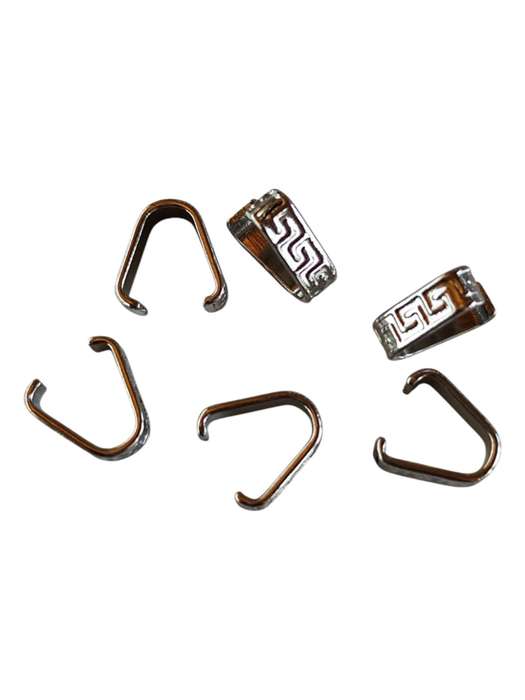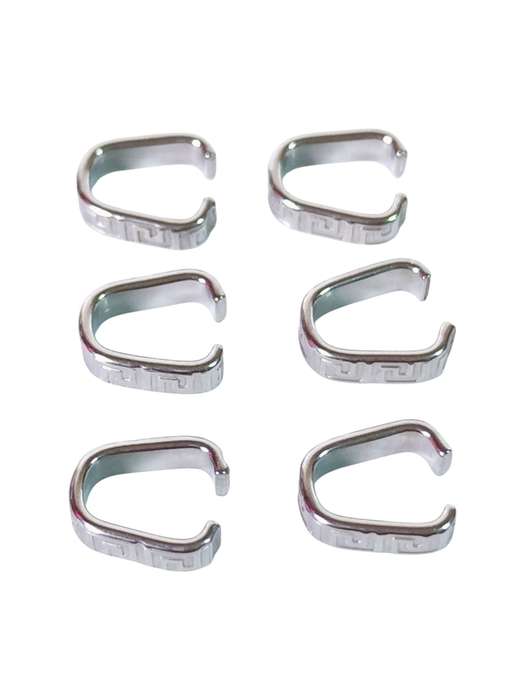



6 x Stainless steel bail with Greek pattern design, 12.6mm
Check my rate
| Main centres: | 1-3 business days |
| Regional areas: | 3-4 business days |
| Remote areas: | 3-5 business days |




| Main centres: | 1-3 business days |
| Regional areas: | 3-4 business days |
| Remote areas: | 3-5 business days |
A pinch bail is a jewelry finding designed to attach a pendant or charm to a chain or cord. It consists of two prongs or pegs that insert into the pre-drilled hole of a pendant, and then snap or pinch together, often around a hidden hinge. The top of the bail forms a loop (or bail) through which a chain, cord, or necklace can pass.
The result is a clean, elegant, and secure connection between the pendant and necklace, without visible wires or jump rings.
Stainless steel is extremely strong and resilient, making it ideal for heavy or valuable pendants such as natural stones, crystals, or glass.
Unlike plated or softer base metals, it won't bend, warp, or lose its springiness over time.
No flaking, rusting, or oxidation even when exposed to moisture or skin oils.
Ideal for daily-wear jewelry, including outdoors or in humid climates.
Safe for most people with metal allergies nickel-safe and skin-friendly.
Great for sensitive-skin customers or those looking for allergy-conscious materials.
Doesn't need regular polishing.
Keeps its bright, metallic finish for years with minimal upkeep.
Provides a sleek, modern, and clean finish especially well-suited for minimalist or industrial-style designs.
Often more refined-looking than wire-wrapped or glued bails.
Align the prongs of the bail with the hole of your pendant.
Gently push the prongs through the hole from either side. Some have tiny pointed tips or ribs to grip the material.
Pinch the bail closed using your fingers or pliers (if it's thick stainless steel).
The top loop of the bail is now ready to thread onto a chain or cord.
Some pinch bails have a hinged or snap-close mechanism, adding extra security and ease of use.
| Material | Compatible? |
|---|---|
| Drilled gemstone pendants (e.g., agate, quartz, jasper) | Excellent |
| Glass pendants | Very good |
| Ceramic or porcelain | With caution |
| Resin or polymer clay | But watch for cracking |
| Un-drilled cabochons | Not suitable (unless glued into a setting) |
| Feature | Why It Matters |
|---|---|
| Pegged prongs or teeth | Provides better grip inside the hole |
| Hinged mechanism | Easier to open/close, adds durability |
| Decorative design | Can enhance the aesthetic from plain modern to ornate filigree |
| Bail loop size | Should fit your intended chain or cord thickness |
| Finish (polished, brushed, matte) | Match it to your jewelry style (modern, rustic, etc.) |
Pendant hole size should be slightly smaller than the distance between prongs when open.
Bail loop size should be large enough to slide over your chain, but not so large it looks out of proportion.
| Chain Size | Recommended Bail Loop ID |
|---|---|
| 12 mm cord or chain | 34 mm loop |
| 34 mm leather cord | 56 mm loop |
| 5 mm+ thick chain | 68 mm loop or more |
Turning loose gemstones or beads into pendants quickly
Making bulk pendant necklaces for craft markets or retail
Adding high-end finishes to crystal or mineral jewelry
Quick customization of interchangeable charms
| Bail Type | Pros | Cons |
|---|---|---|
| Pinch Bail (Stainless Steel) | Secure, no glue needed, professional look | Requires drilled pendant |
| Glue-on bail | Easy to use, works with flat backs | Not as strong, glue can fail |
| Wire-wrapped bail | Customizable, artisan look | Time-consuming, requires skill |
| Snap-on bail | Fast to use, versatile | May be bulky or less secure |
Stainless steel pinch bails are a top choice for makers who want:
Durable, long-lasting jewelry findings
A clean, modern finish
Ease of assembly without glue or advanced tools
Hypoallergenic, professional-grade components
They're especially great for: